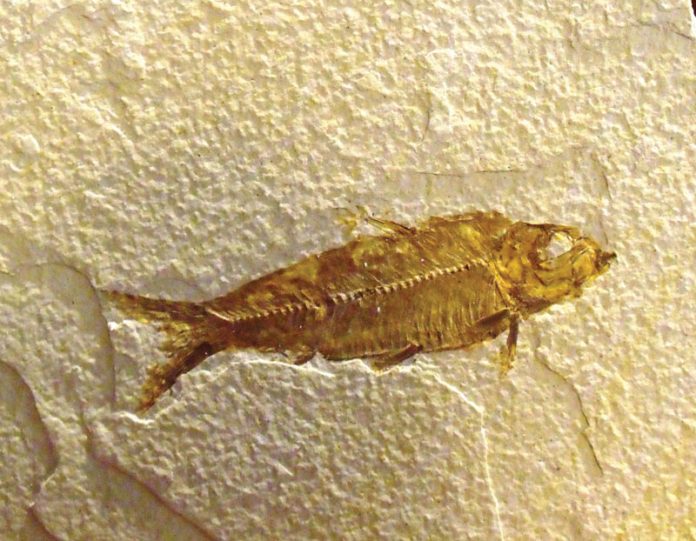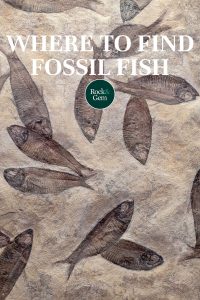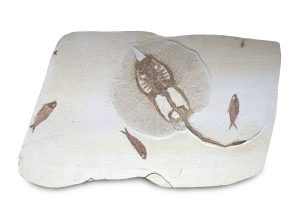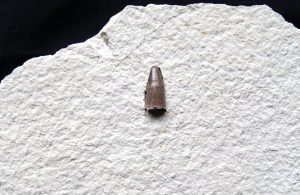
Where to find fossil fish is a common question for fossil enthusiasts and rockhounds alike. Some people like to rockhound on a sand, even pink sand beach picking up really pretty shells, agatized coral and sea glass. Others prefer inland water like Lake Michigan beaches. Some like to hike in the mountains and pick up strange and unusual rocks. Then there are some that like to go fishing… with a hammer and chisel.
Where to Find Fossil Fish – Dig Sites

Two sites outside the small town of Kemmerer, Wyoming, offer pay-to-dig. Just make an appointment or register, show up and they will take great care of you, showing you how to fish… with a hammer and chisel.
One site is the Warfield Quarry, also known online as Fossil Safari, and the other is the American Quarry.
While visiting the pay-to-dig sites in Kemmerer, it is a must to travel a short distance away to the Fossil Butte National Monument. Sorry no collecting here, but the museum boasts a tremendous variety of animals and plants from the Green River Formation. Cut unobtrusively into the hillside, the visitor center is filled with wonderous fossils, a great compilation of the ecosystem 50 million years ago.
The Green River Formation
Pay-to-dig sites are part of the Green River Formation where there are hundreds, no, thousands of fish trapped in rock that was once a series of fairly shallow lakes. Streams and rivers drained the surrounding mountains enabling the formation of this special fossil location.
The Green River Formation is known as a lagerstatte, which loosely translated from German means “storage place.” The area butts up against the limestone of the Wasatch, Unita, Wind River and other mountain ranges. It is an area where fabulous and spectacularly preserved fossils including plants and animals represent a snapshot of life living within that ecosystem.
When & How was this Site Made?

The Eocene period, about 53 to 48 million years ago, was a transition from a warm and moist environment to one that was hotter and drier. This is evidenced by some of the fossil finds in the area. Palm fronds, crocodile and sycamore leaf remains point to a warm moist environment and deciduous tree leaves point to a drier climate. The mountains were partially made up of limestone. During heavy rains, water would run down into the streams and rivers bringing with it sand, mud and silt sediments filled with dissolved minerals such as calcium oxides, inorganic elements and calcium components.
This would wash into the lakes fouling the water, making it turbid and in some cases changing the pH levels. At times the change in the chemical composition of the water was detrimental to the life forms in it.
Fish would die along with many of the other creatures and become buried in the silty sediments. Paleontologists can tell by looking at the various layers, which were deposited during times of drought and which were deposited in times of flood. It is also possible by studying the cross-section of the quarry where the best location is to find fossil fish.
The spectacular fossilization and completeness of the fossil fish is because they were buried quickly. Even the bottomfeeding scavengers were not quick enough or did not survive to disarticulate the bodies of the dead fish. The sediments filtered down to the bottom of the lake and covered the creatures with thin layers. It is within these layers that spectacular fish specimens may be found.
Where to Find Fossil Fish – Digging

In specific horizons, one of which is called the split fish layer, a finely laminated limestone is present that entombed many fish. This is easy to split and if the rock contains a fossil, it splits so that you can easily see it in both a positive fish fossil and also a negative impression. The fish are beautifully preserved with bones, gill covers, ribs and even scales intact. In some cases, a bit of matrix, the limestone that clings to the fish skeleton, is still present. It is quite easy to remove. In many instances, all that is needed is a dental pick, or a pin vise to gently remove excess rock matrix. You must be very careful not to go too deep into the limestone so it’s best to attack it at an acute angle.
This limestone is so fine-grained that many plants and insects that fell into the water or were washed in from rivers and streams are also seen in spectacular detail.
In some areas birds, reptiles, turtles and even crocodiles may be found all preserved in exquisite detail.
This story about where to find fossil fish previously appeared in Rock & Gem magazine. Click here to subscribe! Story and photos by Joseph “PaleoJoe” Kchodl.













